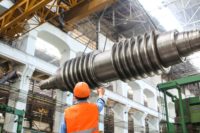 Industrial facilities often attract birds, some of which may cause problems for site operation and management.
Industrial facilities often attract birds, some of which may cause problems for site operation and management.
Bird problems at industrial sites include:
- Impediment to operations—birds and their nests or droppings may interfere with plant operations.
- Property damage—birds and their droppings are messy and can cause damage to structures and equipment.
- Health and safety concerns—birds and their droppings can sometimes give people diseases such as Histoplasmosis, Cryptococcosis, Salmonellosis, Cryptosporidiosis, and Avian Influenza. Accumulations of droppings are also a slipping hazard to pedestrians.
- Regulatory issues—native birds and their nests are protected by federal and other laws, so they need to be protected or humanely excluded from sites where they are a problem.
Birds on buildings
Birds are usually deterred from nesting or causing problems on buildings or other structures with appropriate bird control technologies. Birds on roofs, ledges, and other structures are often excluded by humane plastic or stainless steel bird spikes or an electric bird jolt flat track. Birds nesting or roosting inside or under building structures are usually best excluded with durable and virtually invisible bird netting
Birds in buildings
Birds should be denied entry to industrial facilities, especially those associated with processing, manufacturing, or storing human food. Openings larger than one inch across should be sealed with bird netting or other physical barriers. Large open doorways should be blocked with vinyl strip doors or other barriers whenever possible. If buildings cannot be sealed, bird netting or other barriers should be installed to keep birds from roosting or nesting in rafters or other overhead areas.
Common Bird Problems
- Pigeons congregate where there are food sources such as waste food or garbage, and at covered nesting sites such as open buildings, ledges, and sheltered utility structures. Whenever possible, exclude pigeons by using bird spikes where they congregate or bird netting where they nest.
- European Starlings and House Sparrows are attracted to grain and other food processing operations. They nest in vents, gutters, or other holes in buildings, causing property damage and potentially harboring disease organisms. Block these birds using netting, screening, or other physical barriers to seal all holes larger than 1 inch in diameter.
- Crows may roost for the night in large numbers on building rooftops or other industrial structures. Large flocks may need to be moved by a pest management professional, but smaller groups are often deterred by a Bird Chase Super Sonic sound deterrent,
- Gulls are attracted to garbage, other wastes, rooftops, and open water. Remove potential food sources from the site, and block access to rooftops with bird spikes or an electric bird jolt flat track. Gulls on industrial ponds can be excluded by nylon coated bird wire suspended over the pond in a 20 x 20 foot grid and with a line 6 inches high around the perimeter.
- Ducks and Geese can be excluded from industrial ponds with a similar wire grid.
For most bird problems, appropriate bird control technologies provide a workable solution that humanely and legally preserves plant operation while protecting property, health, and safety at industrial sites.


